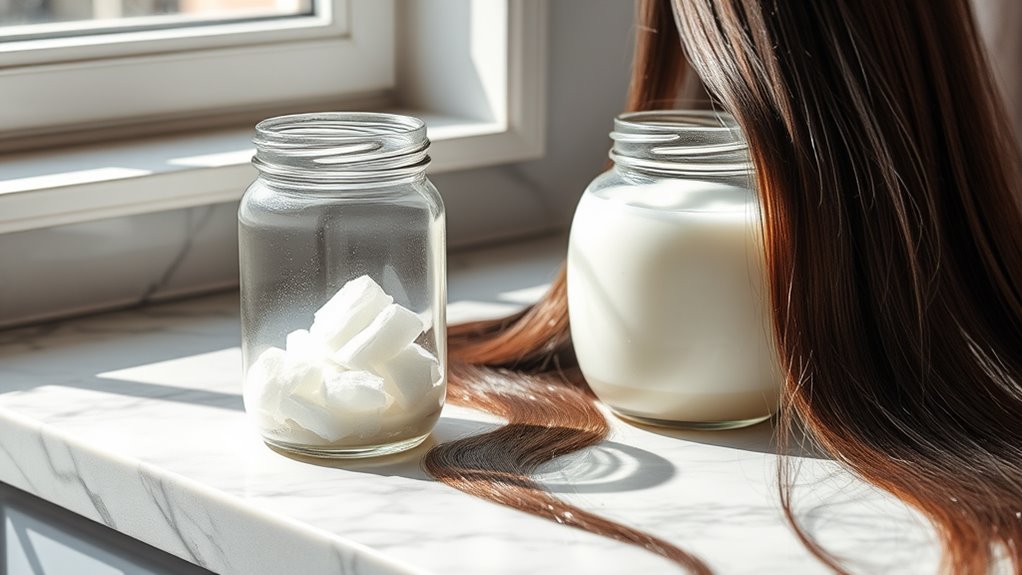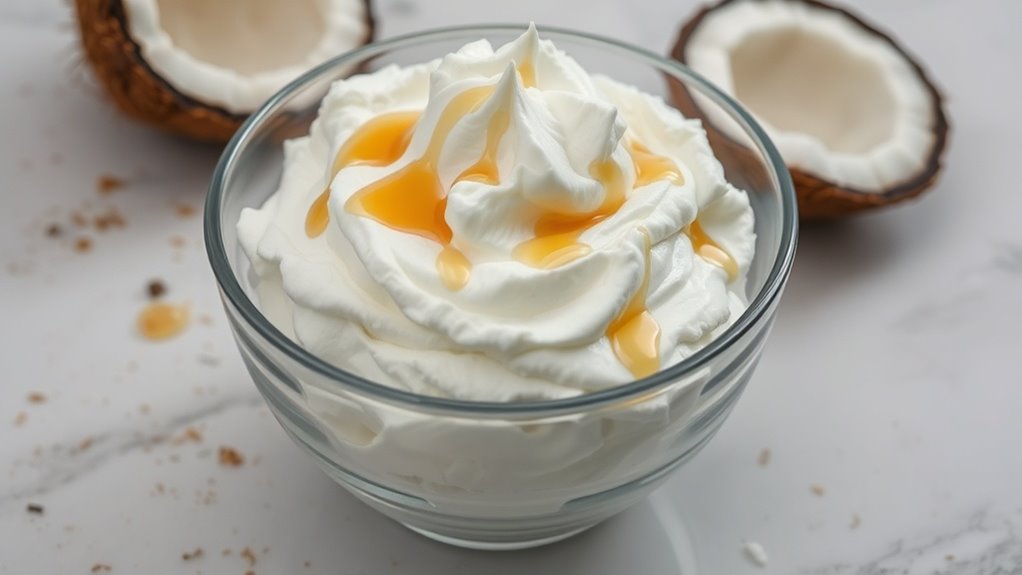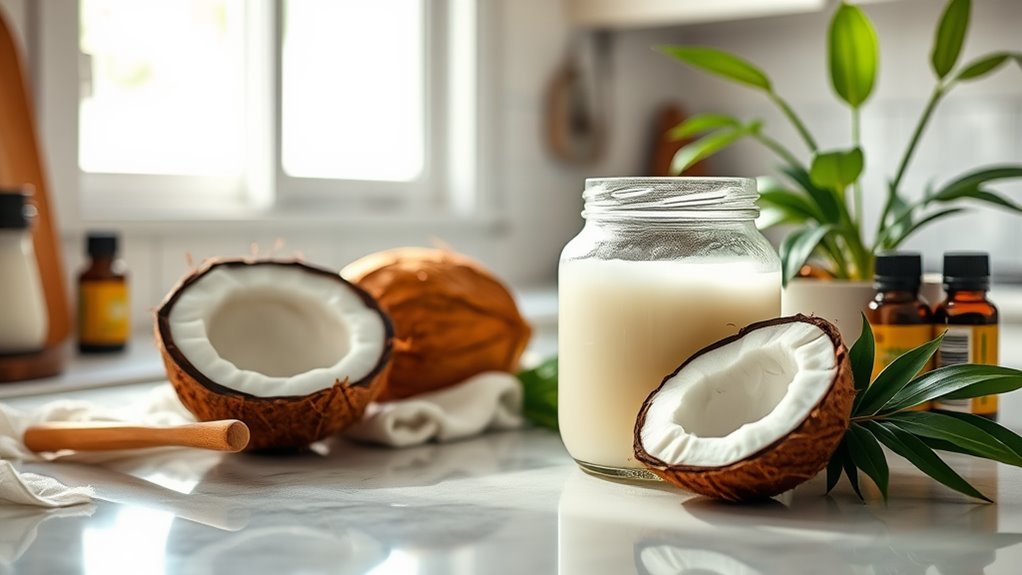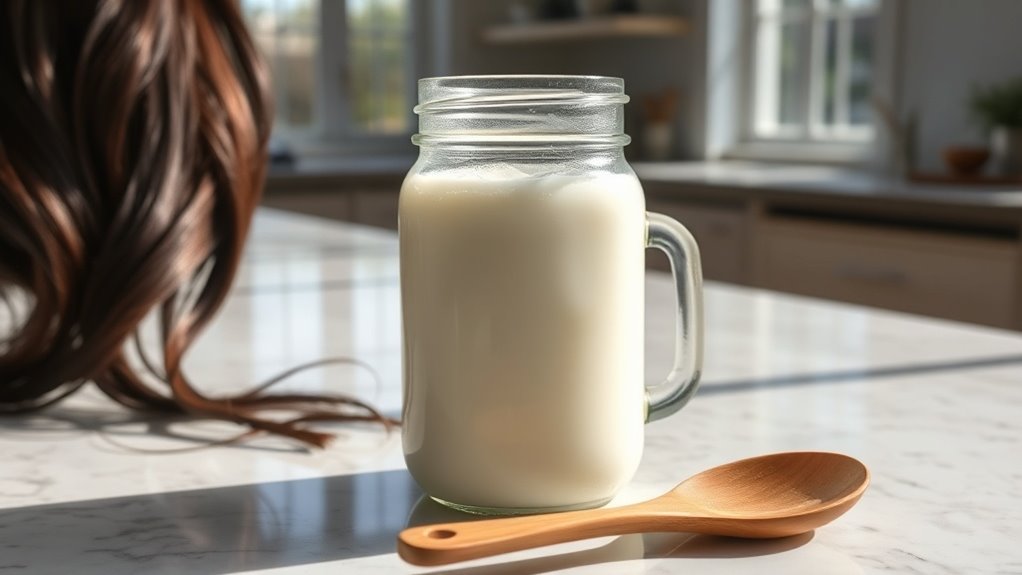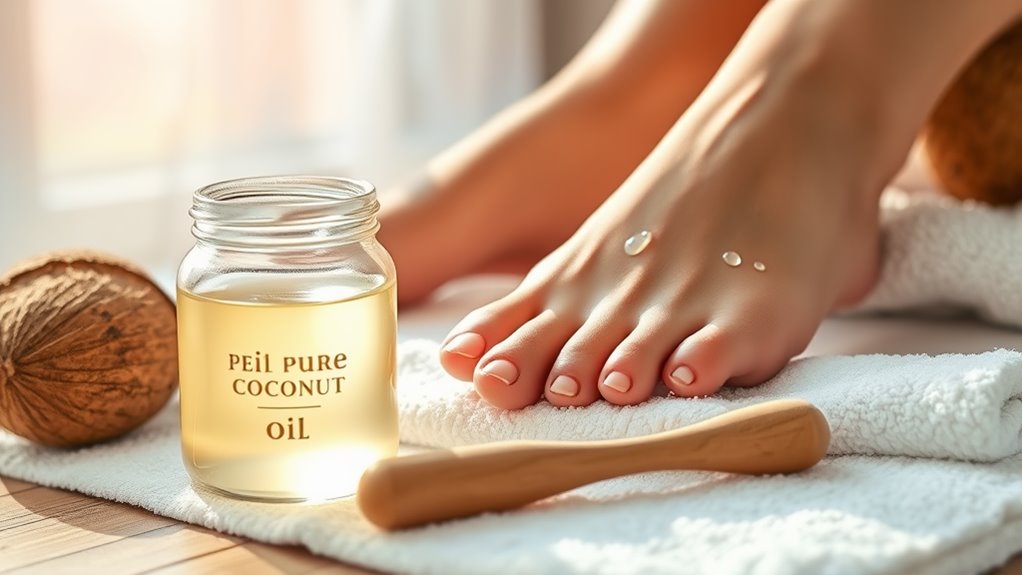The Coconut Oil Hack That Helps Frizzy Hair
Coconut oil’s unique molecular structure makes it your ultimate frizz-fighting solution. When you apply warm coconut oil to dry hair, its medium-chain fatty acids penetrate deep into the hair shaft, filling cuticle gaps and creating a protective barrier against humidity. You’ll need to section your hair and work the oil from mid-lengths to ends, leaving it on for 30 minutes to overnight. This natural remedy doesn’t just tame frizz – there’s so much more to discover about its transformative powers.
Why Frizzy Hair Occurs and How Coconut Oil Helps
Have you ever wondered why your hair becomes an unmanageable, frizzy mess on certain days? The culprit is often humidity, which causes your hair’s cuticle layer to lift and absorb moisture from the air, resulting in that dreaded frizz.
Among popular frizzy hair remedies, coconut oil stands out because it penetrates deep into the hair shaft. Its molecular structure allows it to fill gaps in your hair’s cuticle, creating a protective barrier that prevents moisture absorption. The oil’s fatty acids also help reduce protein loss, strengthen strands, and seal the cuticle layer, leaving your hair smoother and more manageable. Additionally, medium-chain fatty acids in coconut oil contribute to its ability to penetrate deeply into the hair, enhancing its effectiveness.
The Science Behind Coconut Oil’s Hair-Smoothing Properties
The molecular composition of coconut oil makes it uniquely effective for smoothing frizzy hair.
Its structure of medium-chain fatty acids, particularly lauric acid, allows deep penetration into the hair shaft where it bonds with hair proteins.
- Your hair’s protein structure readily accepts coconut oil because its molecular weight and straight linear chain match your hair’s natural composition.
- The oil’s lauric acid content creates a protective barrier that prevents humidity from entering your strands.
- Coconut oil’s hydrophobic properties repel water molecules that cause frizz.
- Its antimicrobial properties help maintain a healthy scalp environment, reducing overall hair damage. Additionally, coconut oil creates a protective barrier against humidity, significantly reducing frizz.
Step-by-Step Application Guide for Best Results
To get the most out of coconut oil’s frizz-fighting benefits, start by applying a small amount to completely dry hair, focusing on the mid-lengths and ends. You’ll want to leave the oil on your hair for at least 30 minutes, though you can extend this to overnight for maximum absorption and effectiveness. After the treatment time, thoroughly rinse your hair with warm water and follow with your regular shampoo, making sure to wash until the oil is completely removed. Additionally, the unique molecular structure of coconut oil allows for deep penetration into the hair shaft, enhancing its effectiveness.
Apply to Dry Hair
Before starting your coconut oil treatment, make sure your hair is completely dry and free from styling products to maximize absorption.
This allows the coconut oil to penetrate deeply into your hair shaft, delivering maximum nourishing benefits.
- Divide your hair into 4-6 manageable sections using hair clips
- Take a small amount of coconut oil and warm it between your palms until it’s completely melted
- Work the oil through each section from mid-length to ends, using your fingers to distribute evenly
- Pay special attention to particularly frizzy areas and damaged ends, applying additional oil as needed
Leave-in Time Guidelines
Once you’ve applied coconut oil to your dry hair, determining the right leave-in duration becomes essential for achieving ideal frizz-reducing results.
For mild frizz, leave the oil in for 30 minutes to 2 hours.
If you’re battling severe frizz or damaged hair, keep it on for 4-8 hours or overnight.
Don’t exceed 24 hours, as this can lead to product buildup and scalp issues.
For best results, wrap your hair in a warm towel or shower cap during the treatment.
This helps the oil penetrate deeper into the hair shaft, maximizing its moisturizing and smoothing benefits.
Rinse and Shampoo Method
The proper rinse and shampoo process makes all the difference in achieving silky, frizz-free results from your coconut oil treatment.
Your technique during this final step can impact how well your hair absorbs the nourishing benefits.
-
Start with lukewarm water to gently rinse your hair, allowing the oil to begin emulsifying
-
Apply a sulfate-free shampoo directly to your roots, massaging in circular motions for 2-3 minutes
-
Work the shampoo down through your mid-lengths and ends while adding more water
-
Rinse thoroughly until water runs clear, then follow with your regular conditioner
Top Benefits of Using Coconut Oil for Hair Care
Natural coconut oil stands out as one of beauty’s most versatile ingredients, offering multiple benefits for transforming frizzy, unmanageable hair into smooth, healthy locks. You’ll discover that regular use penetrates deep into hair shafts, providing essential moisture and protection. Additionally, its antimicrobial properties promote scalp health, further enhancing your hair’s overall condition.
| Benefit | How It Works | Results |
|---|---|---|
| Moisture | Penetrates cortex | Reduces dryness |
| Protection | Creates barrier | Prevents damage |
| Protein | Binds to keratin | Strengthens strands |
| Shine | Smooths cuticles | Enhances luster |
Coconut oil’s unique molecular structure allows it to work both as a preventive treatment and a restorative solution for damaged hair, making it your ideal natural ally against frizz.
How Often to Apply and Timing Recommendations
Determining your ideal coconut oil treatment schedule depends largely on your hair type and its current condition.
For best results, consider these timing recommendations:
- Fine hair: Apply once weekly for 2 hours before shampooing to avoid weighing down strands.
- Medium hair: Use twice weekly, leaving the treatment on for 2-4 hours each time.
- Thick/coarse hair: Apply 2-3 times weekly, with overnight treatments for maximum absorption.
- Damaged/chemically treated hair: Start with twice-weekly treatments, gradually reducing to once weekly as hair health improves.
Remember to adjust frequency based on how your hair responds to the treatments. Additionally, high concentration of lauric acid in coconut oil helps to moisturize and fight fungal infections, enhancing the effectiveness of your hair mask routine.
Common Mistakes to Avoid When Using Coconut Oil
While coconut oil offers remarkable benefits for frizzy hair, many people unknowingly make application mistakes that can diminish its effectiveness.
Don’t apply the oil to dry hair, as it won’t penetrate effectively. Instead, dampen your hair slightly first.
Avoid using too much oil, which can leave your hair looking greasy and weighed down.
Never apply coconut oil directly to your scalp if you’re prone to acne or have a sensitive skin condition.
Don’t skip patch testing, and don’t leave the oil in your hair for longer than overnight.
Remember to thoroughly shampoo afterward to prevent product buildup. Coconut oil penetrates deep into the hair shaft, so it’s crucial to follow these guidelines for optimal results.
Additional Ingredients to Enhance Your Hair Treatment
You’ll increase the effectiveness of your coconut oil hair treatment by adding natural enhancers like honey, which deeply conditions and locks in moisture.
Essential oils, particularly lavender and rosemary, can boost shine while providing aromatic benefits to your frizz-fighting routine.
For an extra dose of nourishment, consider mixing in pure aloe vera gel, which soothes the scalp and helps repair damaged strands while working synergistically with coconut oil. Additionally, medium-chain fatty acids found in coconut oil further enhance its ability to penetrate the hair shaft and provide lasting hydration.
Honey for Deep Conditioning
Natural honey serves as an excellent companion to coconut oil when treating frizzy hair.
Its humectant properties help lock in moisture while adding shine and softness to your strands.
When you combine honey with coconut oil, you’ll create a powerful deep conditioning treatment.
- Mix one tablespoon of raw honey with two tablespoons of melted coconut oil
- Apply the mixture to damp hair, focusing on mid-lengths and ends
- Leave the treatment on for 30-45 minutes under a shower cap
- Rinse thoroughly with lukewarm water, then shampoo and condition as usual
Essential Oils for Shine
Looking to amplify your coconut oil hair treatment? Essential oils can transform your hair care routine by adding extra nourishment and incredible shine. Mix a few drops of your favorite essential oil into your coconut oil base for enhanced benefits.
| Essential Oil | Benefits | Drops to Add |
|---|---|---|
| Lavender | Soothes scalp, promotes growth | 3-5 drops |
| Rosemary | Strengthens hair, prevents breakage | 4-6 drops |
| Peppermint | Stimulates follicles, adds shine | 2-4 drops |
For best results, combine your chosen essential oil with two tablespoons of warm coconut oil. Massage the mixture into your scalp and work through to the ends. Your hair will thank you!
Aloe Vera Benefits Added
While essential oils can elevate your coconut oil treatment, adding aloe vera creates an even more powerful hair-smoothing combination.
This natural duo works together to combat frizz while delivering deep moisture to your strands.
- Mix fresh aloe vera gel with warm coconut oil for enhanced penetration into the hair shaft
- Benefit from aloe’s natural enzymes that repair and strengthen damaged cuticles
- Experience reduced scalp inflammation thanks to aloe’s anti-inflammatory properties
- Lock in moisture more effectively with aloe’s humectant properties working alongside coconut oil’s sealing abilities
Apply this enriched treatment to damp hair, focusing on frizzy areas and split ends.

